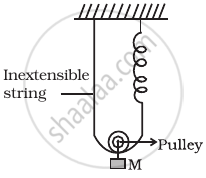Advertisements
Advertisements
प्रश्न
Which of the following statements is/are true for a simple harmonic oscillator?
- Force acting is directly proportional to displacement from the mean position and opposite to it.
- Motion is periodic.
- Acceleration of the oscillator is constant.
- The velocity is periodic.
उत्तर
a, b and d
Explanation:
Simple harmonic motion is a type of periodic motion or oscillation motion where the restoring force is directly proportional to the displacement and acts in the direction opposite to that of displacement. When the system is displaced from its equilibrium position, a restoring force that obeys Hooke’s law tends to restore the system to equilibrium. As a result, it accelerates and starts going back to the equilibrium position.
An oscillation follows simple harmonic motion if it fulfils the following two rules:
- Acceleration is always in the opposite direction to the displacement from the equilibrium position.
- Acceleration is proportional to the displacement from the equilibrium position.
Let us write the equation for the SHM x = a sin(ωt + `phi`)
Clearly, it is a periodic motion as it involves since function.
Let us find velocity of the particle, `v = (dx)/(dt)`
= `d/(dt) (a sin(ωt + phi))`
= `aω cos(ωt + phi)`
Velocity is also periodic because it is a cosine function.
Now let us find acceleration, `A = (dv)/(dt)`
= `(d^2x)/(dt^2)`
= `- aω^2 sin(ωt + phi)`
The acceleration is a sine function, hence cannot be constant.
⇒ `A = - (ω^2a) sin(ωt + phi) = - ω^2x`
Force, F = Mass × Acceleration
= mA
= – mω2x
Hence, force acting is directly proportional to displacement from the mean position and opposite to it.
APPEARS IN
संबंधित प्रश्न
When the length of a simple pendulum is decreased by 20 cm, the period changes by 10%. Find the original length of the pendulum.
The acceleration due to gravity on the surface of moon is 1.7 ms–2. What is the time period of a simple pendulum on the surface of moon if its time period on the surface of earth is 3.5 s? (g on the surface of earth is 9.8 ms–2)
A simple pendulum of length l and having a bob of mass M is suspended in a car. The car is moving on a circular track of radius R with a uniform speed v. If the pendulum makes small oscillations in a radial direction about its equilibrium position, what will be its time period?
A clock regulated by seconds pendulum, keeps correct time. During summer, length of pendulum increases to 1.005 m. How much will the clock gain or loose in one day?
(g = 9.8 m/s2 and π = 3.142)
Show that, under certain conditions, simple pendulum performs the linear simple harmonic motion.
A simple pendulum has a time period of T1 when on the earth's surface and T2 when taken to a height R above the earth's surface, where R is the radius of the earth. The value of `"T"_2 // "T"_1` is ______.
A particle executing S.H.M. has a maximum speed of 30 cm/s and a maximum acceleration of 60 cm/s2. The period of oscillation is ______.
Find the time period of mass M when displaced from its equilibrium position and then released for the system shown in figure.

A cylindrical log of wood of height h and area of cross-section A floats in water. It is pressed and then released. Show that the log would execute S.H.M. with a time period. `T = 2πsqrt(m/(Apg))` where m is mass of the body and ρ is density of the liquid.
A particle at the end of a spring executes simple harmonic motion with a period t1, while the corresponding period for another spring is t2. If the period of oscillation with the two springs in series is T, then ______.
